Solar PV Installation Guide
Welcome to our comprehensive installation guide. This is a guide for installing a retrofit solar PV installation on a residential property. The guide will walk you through your solar PV Installation.
Meet the team
We’ll usually send a team of four to fit each home system – a project manager, two roofers and an electrician. We match skills within each team carefully to make sure we cover all necessary areas of expertise. Your project manager will be responsible for making sure your project is completed on time and to our high standards. They’ll also explain the system to you and answer any questions.
How long will it take?
Most installs can be completed within one to two days, but some will run into three – for example, we’ll take more time when installing on roofs with slate or rosemary tiles as they’re more fragile. We can usually tell which projects are likely to take longer than a day, so we’ll be sure to let you plan for this well in advance.
Do I need to do anything?
All you need to do is give us access to all the spaces we’ll need to work in – both inside and out. We’ll also need to use your electricity supply, water and toilet. We promise to keep any disruption to a minimum and tidy up before we leave.
What’s in the van?
On the day of your install, before we get on the roof and start putting anything on, you’ll see us unloading all sorts of complicated-looking kit. Here’s what everything is:
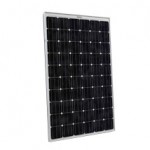 Solar panels
Solar panels
All the solar panels we stock are made up of individual solar cells, covered in an antireflective glass sheet, surrounded by a lightweight aluminium frame. The weight of the panels can vary between 15 and 30kg depending on the size and manufacturer.
One of our panels, the Suntech mono-crystalline 250W panel, shown on the left, for example weighs 19kg and is 1.6 x 1m in size. You can check the specifications of your panels on our website.
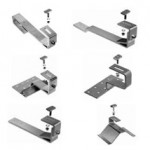 Roof anchors
Roof anchors
These are the stainless steel hooks that screw into the rafters of your roof, forming a base for the mounting system. The roof anchors are hidden from view once the panels have been fixed on to the roof but are nonetheless a crucial part of your system.
There are many types of roof anchors, and the one we use will depend on the type of roof tiles – there are different types for slates, rosemary and concrete tiles amongst others. Our in house technical team will assess which ones to use after we carry out your site survey.
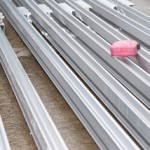 Mounting frame
Mounting frame
The frame is made up of two parallel aluminium bars or rails for each row of panels. The rails are attached to the roof anchors using a specially engineered locking system to ensure there’s no movement, then the panels are mounted on top and attached by clamps.
When choosing the railing for your frame, there are options for black rails if you have all-black panels or panels with a black frame.
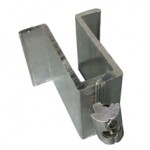 Clamps
Clamps
Clamps hold the panels onto the frame. There are two types: end-clamps and mid-clamps. End-clamps are used at the end of a row of panels fixing the last one in place, while mid-clamps sit between two panels and ensure they’re spaced equally, usually 200mm apart.
We use at least four clamps to secure each panel, and where black panels are used, we have specially coated black panels to help the mounting frame blend in with the panels.
Your install, in eight steps:
Step 1 | Erecting the scaffold
We’ll arrange for scaffold to be put up by a trusted local supplier from our approved network that stretched across the country. The scaffolding will go up two days before the installation to make sure there is plenty of time to make everything safe for our installers. Unlike many other installers, we always include the cost of the scaffold in our quote so you know exactly where you stand.
The scaffolding is erected to provide a working platform for our roofers at the eaves of the roof and safety rails that run along the edges of the roofs. We will always scaffold a roof, no matter how high or low as the safety of our installers is paramount to us.
Step 2 | Fitting the roof anchors
We’ll check the measurements taken during your site survey and make small chalk marks on your roof to show where the panels will go. The chalk will wash off next time it rains.
The next step is to screw the roof anchors to the rafters. First we’ll check where the rafters lie in relation to the existing roof tiles. We’ll position the anchors on top of the tiles in their intended position, then double-check the measurements to make sure the frame will sit straight.
The specific anchors we use as mentioned above will depend on the roof tiles you have. Each anchor and tile has a different fixing method, and our specialist roofers have developed the knowledge to know which is best for your roof during our 5000+ installations.
Step 3 | Attaching the frame
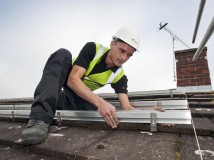 Next the aluminium bars that make up the frame are then locked into the anchors and screwed into place. We’ll check each bar to make sure it’s straight, and that all the bars are parallel. This is the most important step in making sure the panels will look correct.
Next the aluminium bars that make up the frame are then locked into the anchors and screwed into place. We’ll check each bar to make sure it’s straight, and that all the bars are parallel. This is the most important step in making sure the panels will look correct.
Step 4 | Installing the panels
With the bars in place, the next step is to clamp the panels to the frame. Depending on what’s easier, we may fit the panels by row or by column. As well as taking measurements, we’ll check that the panels look straight – not just from where we’re sitting on the roof, but from down on the ground too.
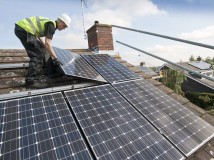 Roofs are very rarely perfectly straight, inevitably the ridge, the eaves and the ground will not run perfectly parallel to each other. PV installations look best when the panels run parallel to the edge that is nearest them, usually the eaves. We understand that after performance the aesthetics are the next most important aspect, so our installation teams will ensure you are happy with the layout.
Roofs are very rarely perfectly straight, inevitably the ridge, the eaves and the ground will not run perfectly parallel to each other. PV installations look best when the panels run parallel to the edge that is nearest them, usually the eaves. We understand that after performance the aesthetics are the next most important aspect, so our installation teams will ensure you are happy with the layout.
Step 5 | Wiring the panels on the roof
Panels are already wired by the manufacturer so connecting them is fairly straightforward. How we connect the panels depends on the system’s voltage, amperage and power, as well as the position of the panels and any shading on the roof. The wires connecting the panels are then kept off the roof tiles by attaching the cables to the rails the panels are clamped to.
Step 6 | Wiring the panels to the inverter
To get the finished system connected, we need to run the DC wiring from the panels into your home. Our electricians always work hard to hide as much of the wiring as possible by routing the cable into the loft space under the panels.
The DC wiring is usually routed into the loft under the tiles, with a protective lead sleeve over them to stop the tiles above damaging the wires over time. If you have a slate roof, we send the cables into the roof using the flashing around a SolarFlash bracket – no slates are drilled, however, they are cut and dressed around the bracket. Similarly, if your roof has rosemary tiles, the cables are sent into the roof through a Solar Limpet bracket.
Step 7 | Inside the home
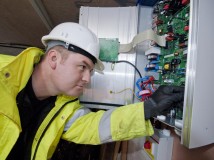 While all this has been happening on your roof, the electrician will have been working hard to get the inverter connected to the rest of your property’s electricity supply. They will have mounted the inverter in a pre-agreed location and installed all the electrical safety equipment to make sure the system is safe.
While all this has been happening on your roof, the electrician will have been working hard to get the inverter connected to the rest of your property’s electricity supply. They will have mounted the inverter in a pre-agreed location and installed all the electrical safety equipment to make sure the system is safe.
Before the final connections can be made, we will also install a small modern consumer unit and generation meter next to your existing fuse box which connects to the existing supply. We will need to switch your power off for around half an hour to do this.
Step 8 | Commissioning the system
This is the exciting bit. Once the wiring’s complete, your project manager will switch on the inverter and power up the system. They’ll send the voltage readings to the team at head office, where we’ll check them against the expected performance and confirm the system’s performing up to standard. The final step is for us to apply for your MCS certificate.

